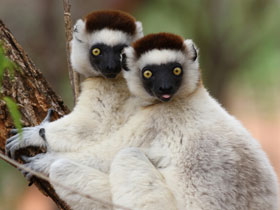Verreaux's sifaka or the white sifaka (Propithecus verreauxi)
Description and distribution
Verreaux's sifaka (Propithecus verreauxi), or the white sifaka, is a medium-sized primate in one of the lemur families, the Indriidae.
It is found in Madagascar, where it inhabits large areas of both rainforest and dry deciduous forest. Its fur is thick, usually white, with dark markings on the sides, head and arms. Like all sifas, it has a long tail, which it uses as a balancer when jumping from tree to tree. Adapted to living in trees, it jumps when moving along the ground. It forms small groups.
It is 42 to 45 cm long and its tail is 56 to 60 cm long. Females weigh an average of 3.4 kg, males 3.6 kg. The skull is relatively low and flat. The face is broader than that of other indriyas and the muzzle is shorter. The upper incisors are very small and point inwards. The lower jaw forms a comb of teeth, the molars have a cusp, which helps to crush leaves when chewing. The thorax is wider than that of most lemurs.
Nutrition and lifestyle
It feeds most often in the morning or early afternoon, resting during the midday heat. Their diet consists mainly of leaves, but they also eat fruit, tree bark and flowers. It prefers leaves with low tannin content.
It is a diurnal animal, which spends the hottest part of the day resting in the sun, stretching out its limbs. They live in the trees, moving in the canopy by leaping, sometimes jumping 9-10 m. On the ground, they move by hopping on two legs.
Behaviour and reproduction
They form small family groups of 2 to 12, consisting of a male and a female, or several males and females at the same time. Territorial behaviour is poorly developed; they tend to protect food sources rather than territory from other groups. Females dominate males in the group.
Females produce an anal-oral secretion that serves to mark territory boundaries, while male secretions (from anal-oral and throat glands) serve more to attract mates than for territorial purposes. Some males have a brown coating of this secretion on their chests.
Males and females sometimes provide fur-cleaning services in exchange for some reward, such as reciprocal grooming or in the mating rut (male offers grooming, female offers mating). Studies have shown that females are more likely to mate with males whose breasts are more tinged with secretion. On the other hand, males with light-coloured breasts are more likely to offer cleaning services to females, which also results in mating.
It has been found that after cases of aggression between two crested Indians, they often reconcile and re-establish friendly relations, usually when food is not involved in the conflict. Crested Indians retain an interest in play well into adulthood, when play is used during the mating season.
Pregnancy lasts 130 days, after which a single calf is born. Births usually take place between June and August. The calf clings to its mother's belly for the first 6-8 weeks, the mother carries the calf on her back for the next 19 weeks.
Ecology and conservation status
The species is listed in CITES Appendix I, and its IUCN conservation status was updated to Critically Endangered in 2020. In the small spiny forest fragments of South Madagascar, sifaka abundance appears to be influenced by the proportion of large trees (diameter at breast height >=5 cm) and by the abundance of the plant species Allouadia procera, a key species of the spiny forest habitat. A long-term, large-scale demographic study of the species at Beza Mahafaly Special Reserve in southwest Madagascar found that the sifaka population there had a population growth rate of 0.98 (with confidence intervals spanning 1), suggesting that the population was not in danger of imminent extinction. However, both severe droughts and an increased annual variation in rainfall levels can depress the population growth rate.

















































